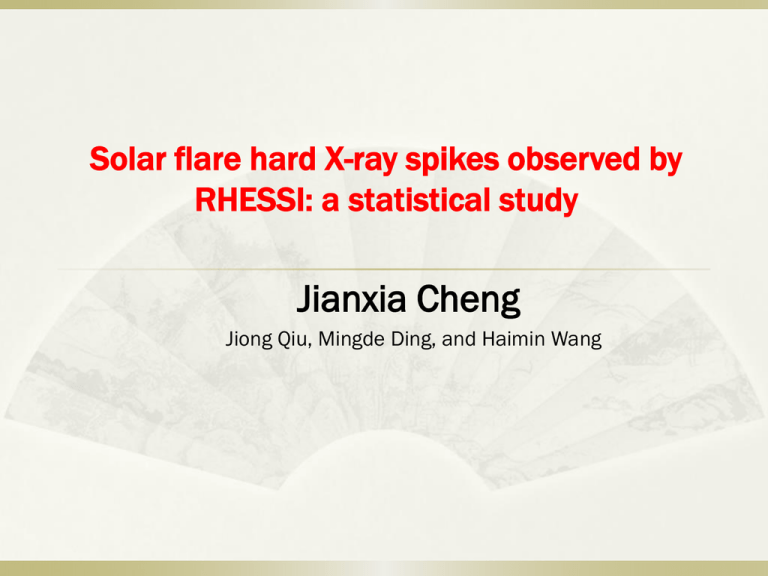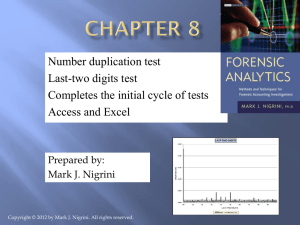spd2013_jianxia_cheng
advertisement

Solar flare hard X-ray spikes observed by RHESSI: a statistical study Jianxia Cheng Jiong Qiu, Mingde Ding, and Haimin Wang outline Introduction Observations and data analysis Properties of HXR spikes summary 1.Introduction Solar flare emission at sub-second was reported in hard X-ray in 70s and 80s (van Beek et al. 1974,1976; Hoyng et al. 1976; de Jager & de Jonger 1978; Kiplinger et al. 1983; 1984, 1989). Kiplinger et al. (1983) found 53 out of 3000 flares produce spikes as short as 45 ms. These energetic flare bursts on short timescales are believed to be nonthermal in nature, and their temporal and spectral properties place constraints on the physical nature of the source. Several mechanisms: dynamic magnetic reconnection (Kliem et al., 2000); nonthermal electron injections. Peak energy differences: time of flight; trap model (the collisional timescale increases with the particle energy). An example: different criteria to define a spike It 25-100 keV Islow Ir 1-7 represents 7 different energy bands Event distribution sample flares Sample flares are steeper than the spike-associated flares, suggesting that more intensive flares have in general a greater chance to produce spikes. HXR spikes can occur in both impulsive and gradual events. spkdistribution 70% of spikes around the peak times of the associated flare spk Time difference between spike peak time and flare start time normalized to the flare rise time Most of spikes discovered in 4060 and 60-100 keV, 20% as high as 100-300 keV. Spikes are most probably nonthermal in nature All these statistical results indicate that spikes are small scale energetic events produced during the most energetic stage of flares. In particular, they tend to occur during the rise phase of intensive flares. On the other hand, impulsive and gradual flares have an equal chance to produce spikes. 3.Properties of HXR spikes Spikes duration is range from 0.2-2s with mean value of about 1s. It is independent of energy bands. Symmetric rise and decay phase, this is different from flares. Nearly all spikes have harder spectral than their underlying components. This is agree with the general scenario that flare HXR emission exhibits a harder spectrum at emission peaks than at valley. Time lags between 60-100 keV and 2540 kev Low energy delay High energy delay The majority of events exhibit time lags shorter than 0.5s. Mean time lag is about 0.8s and -0.74s. Low energy delay High energy delay About or more than 2/3 events are low energy delayed. On average, high energy delayed spikes have a harder count spectrum than low energy delayed events. summary Both impulsive and long duration flares can produce HXR spikes with nearly equal production rates. Flares with high peak count rates are more productive in HXR spikes. Almost all spikes occur in the rise phase of the flares, and a large percentage, up to 70%, of spikes are produced at or about the flare peak times. The mean duration of spikes is about 0.9−1.0 s, independent of photon energies. The rise and decay times of spikes are shown to be almost the same. This differs from ordinary flares that usually have a longer decay phase dominated by thermal emission Most of the spikes can be detected in very high energy bands up to 100−300 keV. The HXR spectra of spikes are harder than those of the underlying slowvarying components. This fact implies the nonthermal origin of spikes. Evident energy-dependent time lags are present in a fraction of spikes, indicative of time-of-flight or Coulomb collision effects. It is also shown that, on average, spikes lagging in high energy emissions have harder spectra than spikes exhibiting lags in low-energy emissions. These numbers are significantly greater than Poisson distribution The negative occurrence is nearly ½ of positive or less Most of our spikes detected are real signals. S1 25-100keV With spike S2 Without spike Time cadence 125 ms Define a spike: I r(t ) I (t ) I slow (t ) nsig nsig 3,4,5 wsmt 4,8s Spike/flare number variations with different criteria








